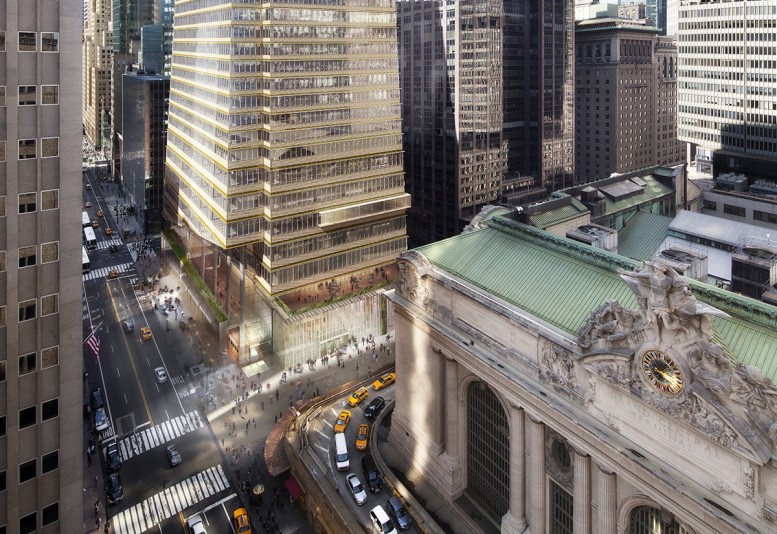SL Green’s 1.6 million-square-foot office tower at One Vanderbilt Avenue will not only be a test case for the city’s ambitious Midtown East rezoning plan, but it’s one of the few times in recent memory that a private developer has agreed to finance and perform substantial construction work for the MTA.
When the City Council approved One Vanderbilt’s special permit in May, the developer promised to promised to fund $220 million in subway improvements for Grand Central that will help ease overcrowding during rush hour. The incredibly congested 4/5/6 station will get a new street entrance, better circulation on the mezzanine level beneath the Hyatt, new staircases, and slimmer columns on the train platforms, allowing the MTA to run one more train per hour.
The firm will excavate 100 feet below street level to create easier transfers between the East Side Access LIRR tracks and the subway, and they’ll add an elevator to bring ESA riders right up to the street. The 63-story office tower will also host two new transit halls spanning 6,500 square feet on the first two floors.
SL Green has essentially written the MTA a blank check. An MTA spokesman assured us that the developer will be responsible for any cost overruns in the construction of subway improvements for One Vanderbilt. They’ll also run the show, construction-wise. The builder will bring in their own contractors, according to a spokesperson for One Vanderbilt. But the MTA will still oversee the work and approve all the designs.
All these exciting upgrades won’t be complete until 2021, at the same time as construction on One Vanderbilt. And East Side Access—a $10 billion boondoggle of a project that required boring huge caverns beneath Grand Central—is tentatively supposed to wrap around the same time in 2022.
Ultimately, the construction will become a fascinating study in whether a private developer can do subway work faster and more cheaply than the MTA. After all, we’re talking about an agency that has spent 40 years building the Second Avenue Subway, which will hopefully run between 63rd and 96th Streets by 2017. By the time the first train runs, the 1.7-mile-long stretch will cost $4.45 billion, or roughly $2.6 billion for each mile of tunnel. While tunneling beneath the city’s complex utility lines and street grid is clearly expensive, MTA projects that haven’t involved major subway construction still came in late and overbudget—like the Fulton Transit Center.
The majority of the MTA’s expenses come from a combination of overstaffing and union agreements, according to Citizens Budget Commission, an independent watchdog group. Running the transit system costs $14 billion per year, and more than half of that cost—roughly $8.6 billion—is related to labor.
And if other developers take advantage of the large density bonuses offered in exchange for investing in transit and infrastructure, we’ll see more examples of SL Green’s model. There will also be an option for those who are willing to simply fund improvements instead of building them. City Planning’s previous proposal called for developers of large properties pay $250 per square foot for any floor area that exceeds a base FAR of 15.
The money would go into a “District Improvement Fund,” vaguely dedicated to “critical transit and pedestrian improvements throughout the area”—i.e. staircases and ramps in the Grand Central subway station, or public plazas and plantings along the street. The steering committee that’s developing the blueprint for the Midtown East rezoning has said they’ll follow a similar path, but they haven’t set the exact cost for air rights or density bonuses.
Developers would also have to pay into the fund in order to buy unused air rights from a landmark. Crain’s reports that there are roughly 4 million square feet of development rights attached to the neighborhood’s 38 landmarked buildings, which could sell for as much as $300 per square foot.
Subscribe to YIMBY’s daily e-mail
Follow YIMBYgram for real-time photo updates
Like YIMBY on Facebook
Follow YIMBY’s Twitter for the latest in YIMBYnews






My Opinion: Comparing work rules in the NYC to those in Spain might be stretching. Megaprojects by the MTA are put out for bid in the private market. While most contractors are union the agency selects through a competitive bid process. A better comparison will occur when S.L. Green begins it’s construction project. But the work rules enjoyed by our Sandhogs have evolved through years of blood and death experience. Of course no rule should be written in stone and should be revisited periodically and re-tested.